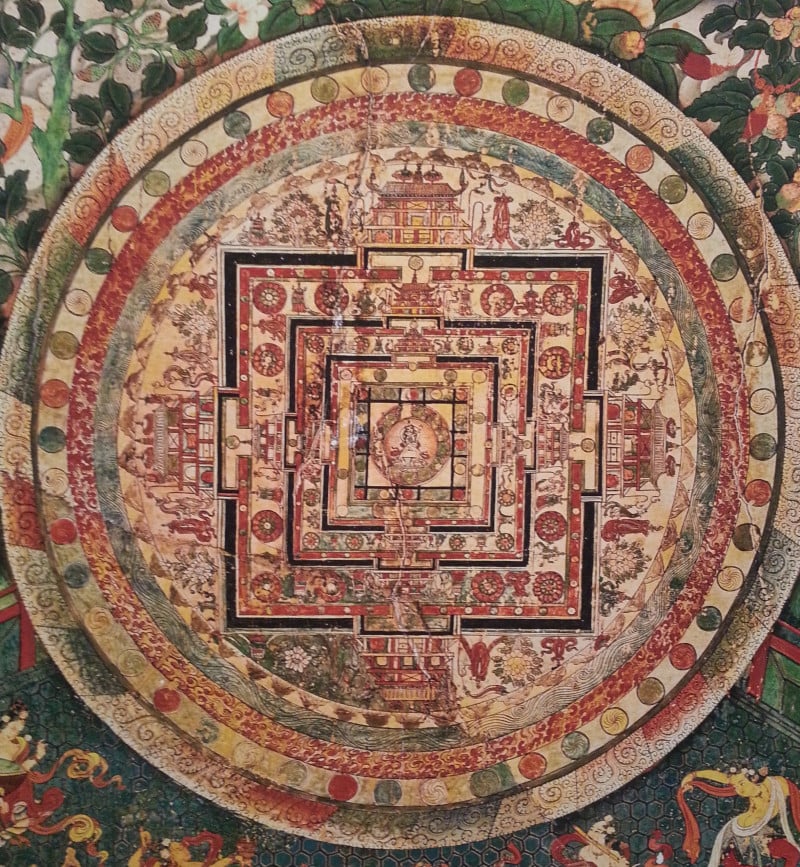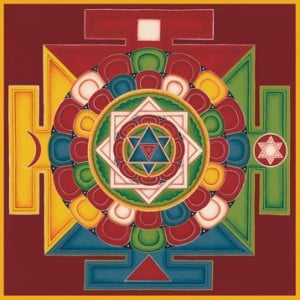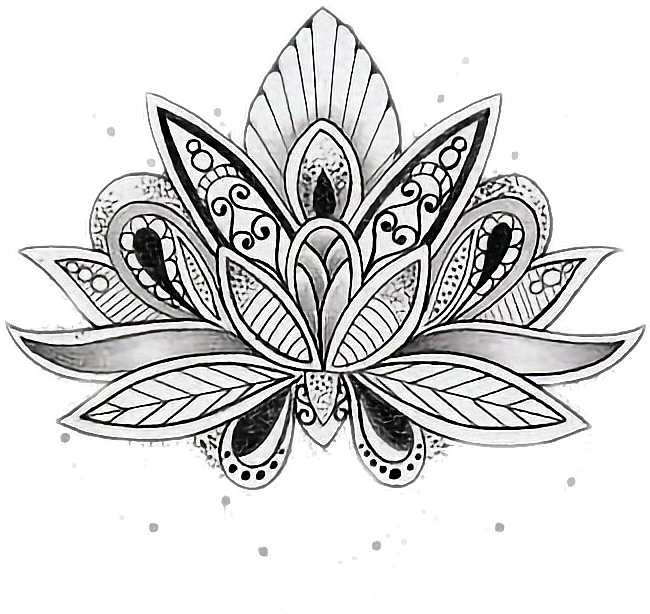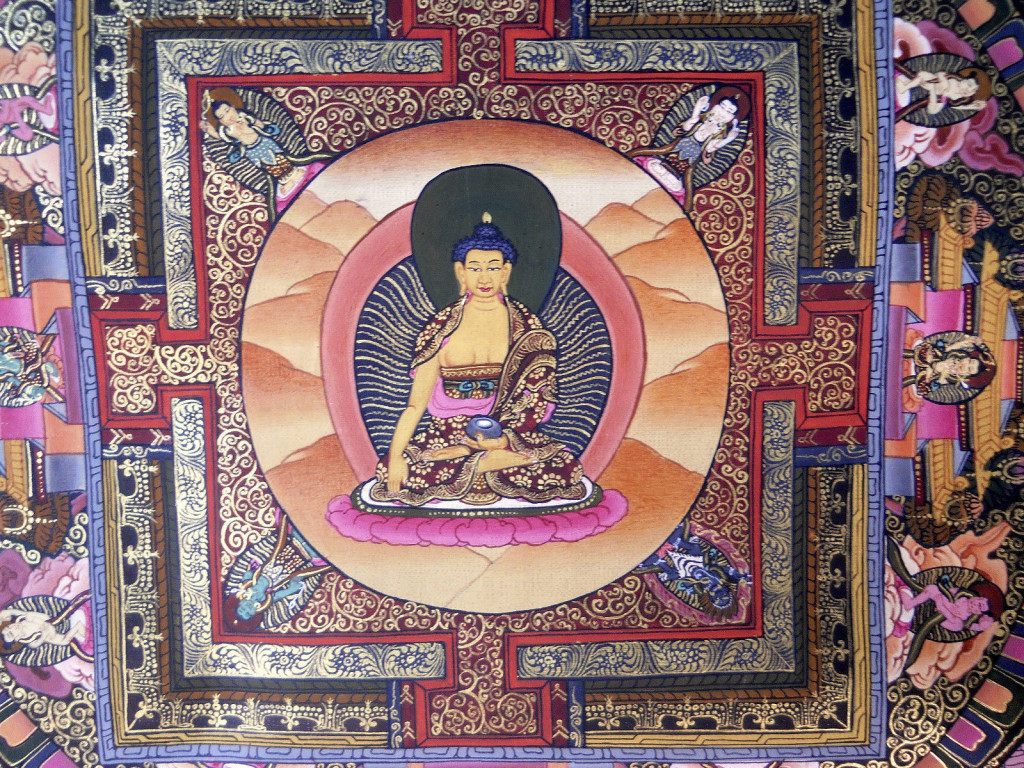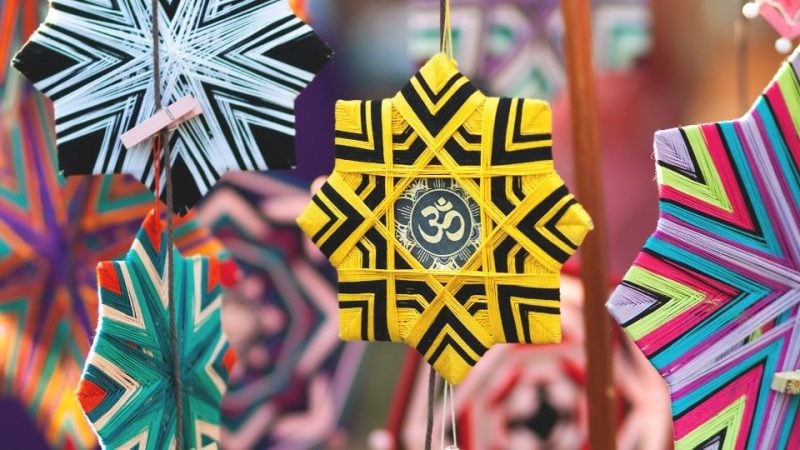
Mandala is one of the most common parts of Asian art. For anyone who is not familiar with spiritualism, it is a symbol of meditation and prayer. You can see them quite commonly in Japanese, Chinese, and Tibetan artworks.
Various cultural prints also feature them. They feature various geometrical prints and shapes and are quite colorful. Once you learn how to spot a mandala, you will start seeing them everywhere. Besides their beautiful looks and artful colors, Mandalas also have a symbolic and meditative meaning.
Mandala Meaning
SUMMARY
Mandala is a Sanskrit word. It means center, circle, or disc. It is a meditative tool, for establishing sacred space, and for representing gods and deities.
Mandala is originally a Sanskrit word, and it means a circle or discoid object. Loosely translated, it can also mean the center. They are ritual and spiritual symbols and they hold a significant position in several East Asian cultures.
As for their shapes, Mandalas usually have repetitive patterns, shapes, and colors that all spread out from the center of the circle. You can find Mandalas that are exact and carefully measured, symmetrical, and geometric. But you can also find ones that are organic, free-flowing, and more artful than geometric. Although most Mandalas are circles, you can also find them in squares.
In some spiritual traditions in the East, Mandalas act as a meditative tool. Beginner as well-advanced meditation practitioners often uses mandalas as a way to enhance focus and concentration. In other cultures, a mandala is a means for spiritual guidance.
A mandala can also be a spiritual tool for inducing trances, or for establishing a sacred space for performing various types of rites and rituals. Some religions also think of mandalas as a way of representing some gods and deities, as well as a map for paradise and shrines.
Although Mandalas are more or less geometric designs, they hold a sprinkling of symbols. These symbols hold different meanings in different cultures.
The Different Meanings of Mandalas
The meaning of a Mandala can be:
- The external representation of the entire universe, this world, the universal forces, and the cosmos beyond it.
- The internal representation of the mind and body.
Due to these two different understandings of what these symbols can mean, Mandalas hold different connotations for different cultures. Some Asian cultures use them as a guide for the internal voice, and a key to understanding the mind. Hence, their meditative usage.
In other cultures like Hinduism and Buddhism, a mandala is something you enter into. As you move towards its center, you go through a cosmic process. You transform your universe from one of suffering and tragedy to that of joy and happiness.
And that’s not the end of different meanings of Mandala.
According to the New Age, a mandala can be a diagram or chart that represents the entire universe or cosmos in its patterns. It holds the key to the structure of life itself. It is a cosmic diagram that shows the connection between the cosmos, and our own minds and bodies.
There is another layer to the meaning of mandalas. While the finished mandala has meditative and spiritual importance, the creation process of a mandala also holds a special meaning. The outer layer of the mandala represents the divine universe. The inner layer represents the connection between the mind and enlightenment. The combination of these two layers represents a balance of the body and the mind, with clarity as to the foundation stone of both.
All in all, mandalas can mean a variety of things to different people.
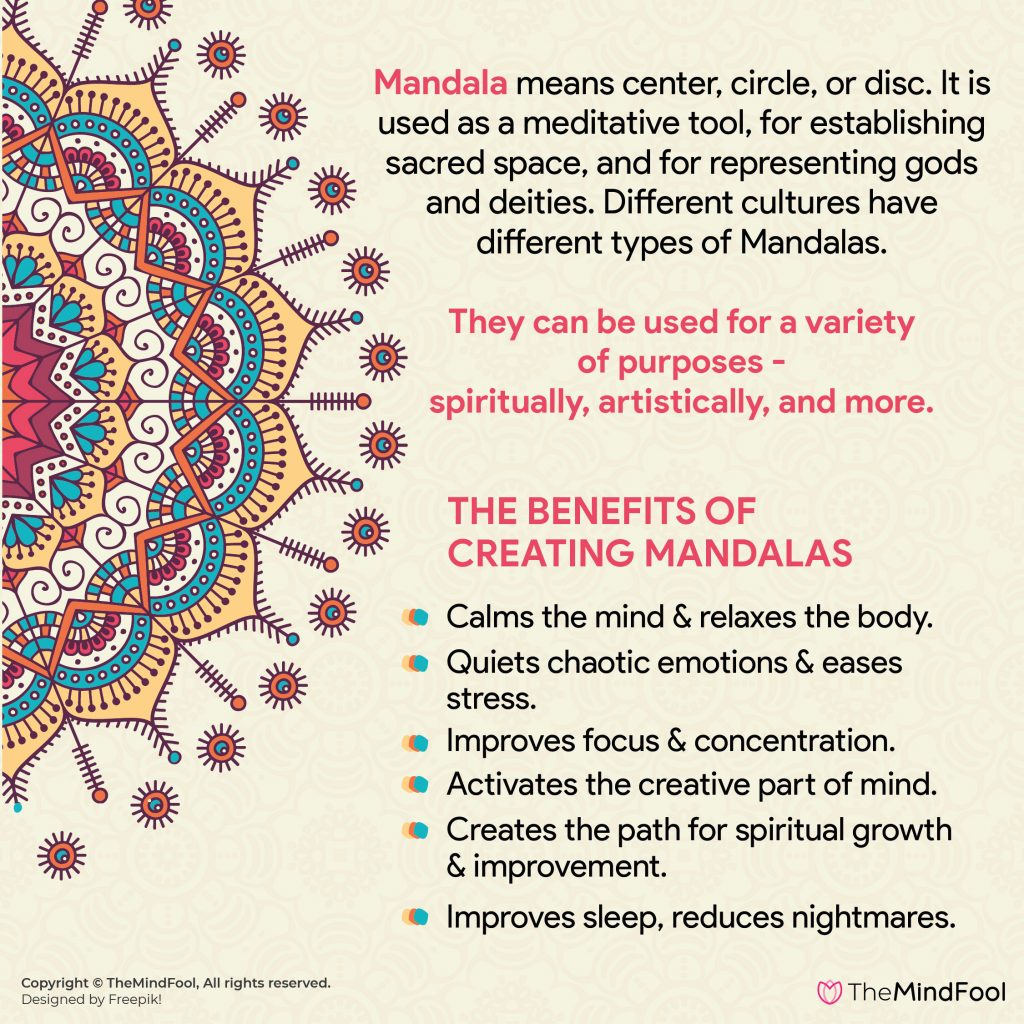
History of Mandalas
The earliest evidence for Mandalas can be found in Buddhist religious artworks and temples. Although the origins of the word lie in Sanskrit, the patterns and shapes that are reminiscent of Mandalas come from Buddhism. Additionally, they were first recorded to have appeared in the first century BCE.
When Buddhist monks took the Silk Road to travel to other countries, they spread the Mandalas to other regions, among other Buddhist influences. These monks took the Mandalas with them and taught people in other parts of Asia how to make them. As a result, the designs and artworks had spread to Tibet, China, and Japan by the 4th century.
Despite their Buddhist origin, Mandalas soon became a common symbol in Hinduism, New Age Spirituality, and other religions.
The Religion Significance of Mandalas
Mandala is one of the most visually rich objects in many religions.
1. Buddhism
In Buddhism, a Mandala is a visual representation of the universe. It can be made on a wall, like a scroll painting, or a regular painting. It can also be created on a table using colored sand.
Buddhism uses mandalas for meditative purposes. It is an imaginary palace that can be the focus during meditation. Every object in this palace has its own significance. They represent any one aspect of Buddhist wisdom or remind the mediator about the guiding principles.
The purpose of the mandala in such practices is to help transform an ordinary mind into an enlightened one. They also help in healing the mind. Certain mandalas in Buddhism also contain deities in their center, and they represent the philosophical views of the religion. They also serve as role models.
Some mandalas in Vajrayana Buddhism are also developed into sand painting. They are parts of various tantra meditation practices as well. They represent the teachings of the religion, as well as the nature of the pure and enlightened mind. Buddhist mandalas can also represent the entire universe and serve as a diagram of the Tibetan cosmology.
Besides this, there are certain specific mandalas that act as symbols of wisdom and impermanence. These Mandalas represent the transient nature of life and remind one to be always mindful of death. Others with various forms of Buddha speak of the different aspects of enlightenment.
2. Hinduism
The Hindu Mandala is a square, and it has four T-shaped gates. They open up towards the center of the Mandala. This configuration is also known as a yantra in Hinduism, although the latter are smaller than traditional mandalas and has only two colors.
A Yantra Mandala can be 2D or 3D and its main use is in pujas and sadhanas. The geometric design of the Mandala in such cases may incorporate a mantra into it. These devices represent the home of the deity whom the people are worshipping. Each Mandala or Yantra used in pujas is unique in its construction and design. Hindu scholars consider them a symbol of the cosmic truths and spiritual aspects of human life.
Yantras and Mandalas have another significance in Hinduism. They are a central focus point for tantric practices. According to certain yogis, they are not tools or representatives of deities, but actual, living, experiencing reality. The Hindus believe that there is a connection between the outer world, that is, the universe, and man’s inner world. The symbols in a Mandala are resonant with the connection of this inner and outer world.
The images and symbols, as well as the sacred geometry of the Mandala also have spiritual significance. According to Hinduism, they are representative of one’s spiritual journey, as well as the cycle of birth, life, and death. The Hindus also believe that the Mandala symbols represent the connection between all living beings and the merging of the self with the divine universe.
3. Christianity
There are many objects in Christianity that are evocative of mandalas. Some of them are, the Crown of Thorns, Rose Windows, Celtic Cross, The Rosary, The Halo, etc.
The meaning of these symbols of Christianity is not that different from the meaning of various types of Mandalas in Hinduism and Buddhism. For instance, one of the most popular Christian meanings of Mandala-like patterns is the journey from the outer world to the inner world, where one can find the sacred Divine.
4. Mayan civilization
The Mayan culture features the Wheel of Time or Kalachakra Mandalas, which are quite similar to the sand paintings by Tibetan Buddhists. This Mandala is in the shape of a wheel and has 260 segments. The Mayans used them for ritualistic purposes, as well as for measuring the 9-month cycle. This interval could be indicative of pregnancies, the cultivation time of some crops, and certain seasons of the year that happened within a 260-days span, like spring and autumn.
Besides this, you can also find Mandalas in:
- Celtic knot works and spirals
- Tibetan sand works
- Dream catchers and shields used by Native Americans
- Yin and Yang symbols in China
- Sandpaintings of Navajo
- Mayan, Astrological, and Gregorian calendars
You can also find mandalas in their most basic form in the natural world. For example, sunflowers, flowers, and snail-shaped shells are prominent ways in which mandalas show up in real life. You can also find mandalas in the cyclical patterns of the moon and various seasons.
Types of Mandala
As mentioned above, different cultures have different types of Mandalas. They have a wide range of applications – spiritual, artistic, and more. Here are 7 main types:
1. Teaching Mandalas
These are symbolic in nature. Every shape, line, and the color is a symbol of an aspect of philosophy or religion. The students can create their own mandalas on the design and construction principles. They can also use them to project whatever they have learned and express it in a visual manner. Certain Mandala creators also use Teaching mandalas for mental mapping.
2. Healing Mandalas
These are more personal than teaching mandalas. They are essentially used for meditation purposes. They can also be used for imparting wisdom and developing a sense of calm in times of anxiety. Some people also use them for channeling their focus and concentration when they find themselves getting distracted.

3. Sand Mandalas
These types of mandalas were originally seen in Buddhism and Navajo cultures. They are traditional in nature and also have religious elements. They are used to express the impermanent nature of human life by using various types of colored sands to make symbols and patterns.

4. Body Mandala
These are internal mandalas and they are used by Tantric practitioners to represent the internal body of a deity, including their organs, veins, and senses. The mandalas are painted on the bodies of the practitioners. They are quite common in both Buddhism and Hinduism, although they are not as popular as outer mandalas.

5. Element Mandalas
Originally used in Indian Ayurvedic Medicine, Element mandalas demonstrate the four elements – fire, earth, water, air, and space. The system was later also used in Tibetan Medicine.
Water is represented by a white circle, the earth with a yellow square, fire with a half-circle that is red in color, and air with a blue triangle. These elements are connected to us and the energies that live within us. They are also connected to our chakras.
6. Lotus Mandala
The lotus mandala represents enlightenment. Just like the lotus flower comes out of the mud to meet the sun rays, the human spirit rises out of the material world to unite with the entire universe. This mandala includes a 3D sculpture of the lotus flower with its stem.
7. Deity Mandala
It is one of the most common types of Mandalas. It saw its origins in the Indian Tantric literature, and it is used as a tool for meditation. Deity mandalas are further divided into many types, like symbol mandalas, figure mandalas, and geometric mandalas.
Symbolism Behind Mandalas
The patterns and imagery used in Mandalas have a host of meanings, both religious and non-religious. Their religious and spiritual symbolism can be understood by examining these patterns and images.
Here are some aspects of Mandala symbolism and the meanings behind these symbols:
Buddha
Buddha is usually included in an abstract way. This can be a wheel, tree, jewel, or the flower of life.
Central Dot
The center of the mandala is a dot. It is meant to represent the beginning of the world, the starting point for contemplation, or devotion to the divine.
The central dot is surrounded by various types of geometrical patterns and symbols. These symbols can mean a host of things, including the universe, the nature of life, etc. Depending on these patterns and symbols, mandalas can have various meanings.
Wheels with eight spokes
Wheels with eight spokes are often used to represent a perfect universe because in Buddhism, a circle is considered perfect. The spokes of the wheel represent the Eightfold Path of Buddhism, which is a set of practices that can help one to liberate from the cycle of birth and rebirth.
Bells
Bells can be used to represent being open to the world. They signify that you should empty your mind, in order to allow wisdom and clarity to enter your consciousness.
Triangles
Triangles are used in Mandalas to represent energy and action when they face upwards. When they face downwards, they represent the pursuit of knowledge and creativity.
Lotus
Lotuses are sacred symbols in Buddhism. Their symmetry means balance. When they are used in Mandalas, they represent the rise of the human consciousness to spiritual awakening and enlightenment.
Sun
Sun is one of the most popular symbols used in Mandalas. It can represent the universe, energy, or life itself.
Characters and scripts
In some Chinese Buddhist traditions, mandalas use Chinese characters and Sanskrit scripts to signify the enlightenment of Buddha, various Buddhist deities, and Buddhist concepts.
Mandala Offering
Tibetan Buddhism uses special Mandalas with intricate symbols in a ritual called Mandala Offering. In it, the Mandala and its patterns are used to represent the universe itself, and the ritual consists of offering the Mandala to Buddha or one of his teachers, as a way of offering the entire universe.
Uses of Mandalas in the Modern World
As mentioned in the previous section, Mandalas have a variety of cultural and religious uses. For instance, the sand art Mandalas used by Tibetan Buddhists are often used to demonstrate the impermanent nature of life.
Buddhist monks spend hours and hours laboring over these sand mandalas. Every grain of sand is placed intricately using pipes to create the perfect textures and shapes. Sometimes, it takes weeks to create the mandalas. And once it is finished, it is destroyed shortly after. This whole exercise exemplifies the Buddhist belief that nothing in this world is permanent.
Besides their use in religious traditions and exercises like the ones mentioned above, Mandalas have a variety of modern-day applications. Here are some examples:
Yoga
In yoga, practitioners often use geometric mandalas to create sacred spaces to drive away any external influences. Yoga studios and meditation clinics often place mandalas all around the working space to infuse the area with positive energy.
Healing Circles
Native Americans also use mandalas to create healing circles, which help in restoring the mind, the body, and the heart.
Dream catchers
Western cultures use mandalas in dream catchers to prevent nightmares and ensure restful sleep.
Adult mandala coloring books
Adult mandala coloring books have become a popular tool for relaxation.
Phylogenetic mandalas
Biologists often use circles to draw Phylogenetic relationships between various species and evolutionary trees. You can make phylogenetic mandalas by lacing the images of different species on the outer edge of the circular diagram.
In architecture
People also use Mandalas in the architectural designs of Buddhist temples, complexes, and stupas. One of the most prominent examples of such a building is the Borobudur in Indonesia. You can also see similar designs in Thailand, Cambodia, and Myanmar.
Therapy
Therapists and meditation guidance counselors often advise drawing mandalas as a way to channel focus, concentration, and help with mood disorders like anxiety.
…which brings me to my next point.
Mandalas and Psychology
It was the Swiss analytical psychologist, Carl Jung, who introduced mandalas to modern, Western psychology concepts.
According to his book Memories, Dreams, Reflections, he used art-making to explore his own unconscious mind. In it, he talked about how the circle would keep appearing again and again in his own drawings. He later stated that it was a reflection of his own state of mind at the moment.
Over time, Jung realized that the circles appeared in his drawings when he was going through periods of intense growth on a personal level. He came to the conclusion that the appearance of the circles indicated that his mind was finding ways to re-balance itself. As a result, his personality became more complex and integrated in a better way.
Since Jung was familiar with the Mandala due to his knowledge of the philosophical work from India, he decided to use the word Mandala to describe these circular drawings that he and his patients would sometimes make. In his book, he wrote:
“I sketched every morning in a notebook a small circular drawing, … which seemed to correspond to my inner situation at the time. … Only gradually did I discover what the mandala really is: … the Self, the wholeness of the personality, which if all goes well is harmonious.”
Jung also came to the conclusion that the Mandala serves two purposes:
- The conservative purpose, which aims to restore a lost previously existing order.
- The creative purpose, which aims to express and form something unique and new, something that doesn’t exist yet.
The latter is extremely important. According to Jung, it is a process of ascending spiral. It is a process of growth and moving forward.
The MARI tool
American art therapist Joan Kellogg carried Carl Jung’s work forward. He also created the MARI card test or the Mandala Research Assessment Tool.
The MARI tool helps people reveal their inner truth and what the reality of their life is by using the geometric shapes and patterns of Mandalas. It is based on Carl Jung’s philosophy of four aspects of consciousness – thinking, feeling, intuiting, and sensing. As a therapeutic tool, MARI helps understand people in a faster and accurate manner, allowing psychologists to provide quality care.
In other words, creating mandalas can help people stabilize their mental world, integrate better with their self, and create a new order for their inner life. To read more on this subject, you can refer to Susanne F Fincher’s Creating Mandalas: For Insight, Healing, and Self-Expression.
Furthermore, David Fontana, a psychologist, and parapsychologist from the United Kingdom, said the following about Mandalas:
“Its symbolic nature can help one to access progressively deeper levels of the unconscious, ultimately assisting the meditator to experience a mystical sense of oneness with the ultimate unity from which the cosmos in all its manifold forms arises.”
You can read more about Fontana’s musings on Mandala in his book, Meditating with Mandalas: 52 New Mandalas to Help You Grow in Peace and Awareness.
To know more about Carl Jung’s work on Mandala, check out the English translation of the lecture by Walter Schwery here:
Creating Mandalas on Your Own
Psychologists and psychiatrists alike have espoused Mandala creation repeatedly. It was Carl Jung who initially introduced the concept of personal mandalas to the Western world. Since then, they act as a tool for expressing the self, the discovery of the self, and for the healing of the self.
The shapes, symbols, and colors of the personal mandala are a reflection of the emotional, spiritual, and mental well-being of the person at the time of creating them. Also, creating and drawing mandalas can change one’s state of mind.
Jung also came to the conclusion that our subconscious and conscious minds are always seeking a balance, and mandala creation can facilitate the same. Psychologists have noted that creating mandalas can help patients calm down their inner, chaotic psychological mental states. They also noticed that the personal mandala design often features the universe, the patterns we see in nature, and other archetypes in these personal mandalas drawn by their patients.
Having said that, when creating your own mandalas, there really are no rules. You can simply make a circle and fill it with any patterns that come to your mind, or you can design intricate shapes and geometric patterns that are symmetrical. Drawing mandalas, especially in times of turmoil and anxiety, has many mental and emotional benefits.
The Benefits of Creating Mandalas
Psychology patients as well as everyday people who have dedicated some time from their life to creating mandalas on a semi-regular basis have seen immense benefits of the practice.
Here are some of them:
- It helps calm the mind and relax the body.
- quiets chaotic emotions and eases any sense of worry, anxiety, fear, depression, stress, or any other overwhelming emotions.
- It creates a feeling of tranquility and contentment and cultivates emotions like inner peace, happiness, and overall well-being.
- It improves focus and concentration.
- Creating Mandalas activates the creative part of the mind.
- It helps in improving one’s self-esteem and can accelerate radical self-acceptance.
- Creating Mandalas creates the path for spiritual growth, as well as personal growth and improvement.
- It creates a sense of connection with the universe, nature, fellow human beings, and the self.
- Creating Mandalas improves sleep, reduces nightmares, and can help with insomnia.
Mandala Art – How to Create a Mandala on Your Own
Mandalas can be a source of relaxation and calm. Here is how you can use mandala painting and draw as a meditative and relaxation tool:
- Set aside 30 minutes to 1 hour to create mandalas. The creation process can take some time.
- Take a few deep breaths before you start. This will calm your mind and center you.
- Start off with a dot. Now draw a cross through the dot to create 4 quadrants. Divide these into 8 segments. As a result, the pattern will remain uniform when you start drawing.
- Now focus on the dot before you continue drawing. Also, allow yourself to connect with your mind, and quieten your inner chatter.
- Start drawing shapes and patterns that come to your mind. They can be repetitive or unique, geometric, or organic, abstract, or images. All that you have to remember is that it should come from within you, free-flowing, without any pressure or external influence.
- Remember to enjoy the practice. There is no rush or pressure to be the best. The process should help you in your personal evolution, that is the only end goal.
- Once your mandala is complete, you can save it for helping with meditation in the future. Since it is a representative of your inner world, you can use it to understand your subconscious as you meditate.
Creating your own mandalas can be very soothing and relaxing. You can do it with any medium or color. It can be temporary like sand painting, or more important. The only limit is your imagination.
For a short introduction into Mandala art, check out this video:
Conclusion
Mandalas don’t just have a historic and religious significance. They are meditative tools and passages for personal and spiritual growth. Making your own mandalas is one of the most soothing mental exercises, and has a range of health benefits.
In today’s hectic world, creating your own mandalas can be a liberating exercise. All you need to begin is your own self.
Surabhi has a deep passion for words. She puts her heart and mind into whatever she pursues and craves for creative ventures. She has always been keen on creating original content that can make a difference. In her experience as a content writer, she has had the opportunity to work on several fields with Psychology being her favorite. Surabhi says, words have the power to transform the world, better than a sword. So she hopes to contribute her bit to this revolution. At TheMindFool, she feels lucky to have the opportunity to share content capable of bringing about a change in the lives of the readers.

